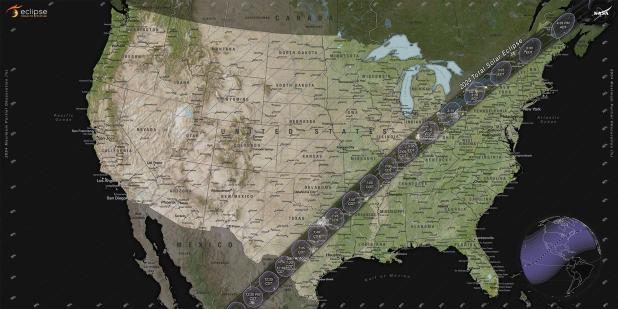
This NASA graphic shows the path in which people will be able to view Monday's total solar eclipse.
Monday is a rare eclipse day -- like, totally
St. Mary Parish residents can get a look at Monday’s solar eclipse just by staying home and looking up — with the proper eye protection, of course.
But to get the full effect of one of astronomy’s greatest shows, you’ll have to travel to the path of totality, a few hundred miles to the northwest.
Monday’s eclipse is a total solar eclipse. The moon will move between the Earth and the sun, and in the path of totality, it will completely obscure the sun’s disk.
The Monday eclipse is notable for a number of reasons. The total eclipse will be visible in a 100-mile wide band stretching from the Mexican border southwest of Dallas and northeast all the way to Maine.
Totality — when the sun is completely obscured by the new moon — is expected to last nearly 4-1/2 minutes and be visible to tens of millions, about twice as long as the 2017 solar eclipse.
Bob Berman of the Farmer’s Almanac describes the spectacle this way:
“People along the path of totality will see the Sun’s corona, or outer atmospheric glow, which is usually not visible due to the Sun’s brightness. The corona forms delicate magnetic lines that leap across the sky.
“And they will see the pitch-black New Moon as it visibly moves in its orbit to intrude upon the Sun! And then there are the prominences — those astounding pink tongues of flame — as they fly up from the Sun’s edge! It’s like nothing else.”
The show will be even better because the sun is near the peak of its sunspot cycle and especially active.
Tens of millions more, including those in south Louisiana, will still be able to enjoy the eclipse. But they’ll have to settle for the eerie darkening effect that occurs during partial solar eclipses.
When
The timeanddate.com website says the partial eclipse, as viewed from Morgan City, will begin at 12:27 p.m. Monday.
The sun will be about 83% obscured by 1:47 p.m., when the moon will begin to reveal more and more of the sun.
The sun will be completely visible again at 3:07 p.m., a duration of 2 hours, 40 minutes.
Protection
The National Aeronautics and Space Administration warns that viewing any part of the bright sun through a camera lens, binoculars or a telescope without a special-purpose solar filter secured over the front of the optics will instantly cause severe eye injury.
When watching the partial phases of the solar eclipse directly with your eyes, which happens before and after totality, you must look through safe solar viewing glasses (“eclipse glasses”) or a safe handheld solar viewer at all times. You can also use an indirect viewing method, such as a pinhole projector.
Berman says viewers “absolutely must wear eye protection for the long partial eclipse stage leading up to totality, specifically a special super-dark filter bearing the international standard ISO 12312-2.”
NASA says Monday’s event will be the last total solar eclipse visible from the lower 48 states until 2044.
